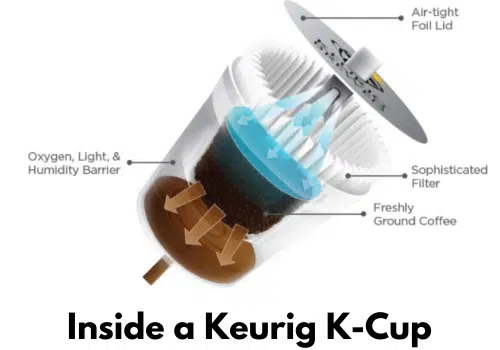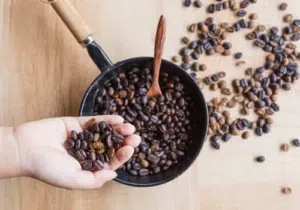How Much Coffee Is In A K Cup? 5-Minute Read
Disclosure: This post contains affiliate links and I may earn a small commission (at no extra cost to you) if you click through and make a purchase. Thanks in advance – I really appreciate it!
I am someone who prefers a full-bodied balanced cup of coffee first thing in the morning. So, before I decided to purchase my first Keurig coffee machine I wanted to know the amount of ground coffee that a K-Cup has in it. Because that’s one of the factors that decides the strength of a cup of coffee.
Key Takeaways:
How much coffee is in a K-Cup?
There are 9-12 grams (0.3-0.4 ounces) of finely ground coffee in the average K-Cup. Breakfast blends usually have 9-9.5 grams, and medium roast K-Cups have 10-11 grams of coffee in them. The dark roast K-Cups have 11-14 grams of coffee which is a little more coffee than the other K-Cups.
The best thing about a Keurig or any pod coffee brewer is that you don’t need to wait for the water to boil or grind the beans yourself. Simply pop in a K-cup, close the lid, click the button and you’re well on your way to a quality cup.
But if you’re curious about what’s inside a K-Cup or how much caffeine does a cup of K-Cup coffee has then read on to find out more!
How Many Grams of Coffee is in a K-Cup?
Those of you who own one can attest: A Keurig coffee maker can change your mornings forever. But not all coffee pods are created equal.
Countless brands manufacture K-Cup coffee today, from well-known names like Starbucks and Folgers to small boutique roasters. It may seem daunting to sort through all the identical little capsules and pick the right one for your taste buds.
A K-Cup coffee pod comes in a variety of flavors. You can pick and choose from different strengths, blends, and flavors such as light roast, medium roast, dark roast, espresso coffee, regular coffee, flavored coffee, caffeinated, decaf, latte’s, hot chocolate, and much more.
But, how much coffee is in an average K-Cup?
On average, a K-Cup contains 9-12 grams (0.3-0.4 ounces) of finely ground coffee.
Light breakfast blend K-Cups from several brands contain 9-9.5 grams of coffee whereas medium roasts have 10-11 grams of ground coffee.
Then there are the “extra bold” dark roasted K-Cups that have 30% more coffee than the others which can amount to somewhere between 11-12 grams of coffee per K-Cup. However, “extra bold” K-Cups from some brands can have as much as 14 grams of coffee in them.
So if you want the most bang for your buck, you may want to stick to robust blends. And keep in mind that if you like your coffee exceptionally strong, you may end up using more than one K-Cup to make a single cup of coffee.
How Many Tablespoons Of Coffee In A K Cup?
On average, a K-Cup contains 9-12 grams (0.3-0.4 ounces) or 2-2.5 tablespoons of finely ground coffee. Generally, light roasts and breakfast blend K-Cups have lesser coffee i.e. around 2 tablespoons, compared to the dark roast blends that can have around 2.5 tablespoons of coffee.
What’s Inside a K-Cup?
Inside a K-Cup, there’s a paper filter that is fixed to the food-safe plastic cup with a food-safe adhesive, along with some ground coffee. The K-Cup has an aluminum foil top which along with the plastic cup prevents oxygen, light, and moisture from degrading the coffee.

Typically, there are two more steps taken to ensure that the coffee doesn’t go bad. First, the beans are allowed to degas (releasing the carbon dioxide that’s a byproduct of roasting).
Then, once the grinds are put into the cup, the air inside is switched with nitrogen, which is inert and helps prevent spoilage.
Most K Cup pods are classified as #7 plastic, which means they are made from a multi-layer blend of materials and plastics.
The inside layers are polyethylene, which is one of the most common plastic food packaging materials used today.
The cup is made to resist moisture, heat, and light to keep its contents secure and fresh.
The aluminum top foil airtight seal seals in coffee ground freshness.
The majority of Keurig K Cup coffee pods contain some of the finest Arabica and Robusta coffees from around the world.
How Much Does a K-Cup Weigh?
An average K-Cup weighs between 12-17 grams or 0.4-0.6 oz depending on the brand. Dark roast weighs slightly more due to more coffee grounds in order to make a stronger roast. The packing for a K-Cup on average weighs around 3–4 grams and the remaining weight is from the coffee grounds.
The list below breaks down the weight of the K-Cups by type:
- Typical k-cups: 12 grams
- Extra bold k-cups: 14 grams
- “Travel mug” k-cups: 16 grams
- Barista Prima k-cups: 17 grams
- REVV: 17 grams
- “Brew Over Ice” k-cups: 17 grams
The only significant way in which the above types of k-cups differ (apart from the obvious fact that different varieties contain different beans roasted to different degrees) is by the amount of coffee they contain.
Accordingly, a “brew over ice” k-cup has no special properties aside from extra coffee, and you may use other types of K-Cups to make iced coffee as well, just with less ice, or the coffee may turn out to be weak.
Some coffee lovers are under the mistaken impression that the only way they can customize the strength of their morning cup is by selecting more or less water to brew with. In fact, one can also control the amount of coffee being brewed by selecting a different type of K-Cup.
How Much Caffeine is in a K-Cup?
An 8 oz (250ml) cup of coffee using the standard 2 oz K-Cup would yield between 75-150 mg of caffeine. The “extra bold” K-Cups have 30% more ground coffee in them which would increase the caffeine content to around 150mg per 8oz cup. Almost all decaf K-Cups also contain some amount of caffeine.
Actually, there are many variables that determine the amount of caffeine in a cup of coffee.
Caffeine varies by roasting type. The light roast coffee contains more caffeine than the dark roast. Beans that are roasted dark are exposed to prolonged heat which breaks down the caffeine.
Different types of beans produce more caffeine than others. The higher-end, better-tasting Arabica beans that produce Keurig K-Cups have less caffeine than their cheaper Robusta counterparts.
The finer that coffee is ground the more caffeine it will contain. Keurig K-Cups coffee is generally ground on the medium to the finer side.
The length of time a coffee is brewed or steeped will affect the amount of caffeine extracted. For example, french press coffee has one of the highest caffeine contents because the general process is to allow the coffee to steep for four minutes.
In general, most coffee has roughly 85 mg of caffeine per 10 g of coffee. If you’re drinking relatively normal coffee, you can use this number to estimate how much caffeine is in your K-Cup.
How Many K-Cups Coffee is it Safe to Consume in a Day?
Most sources recommend limiting your caffeine intake to less than 400 mg per day. That converts to about four cups of regular strength coffee or four K-Cups. Even if you drink two K-Cups worth of dark roast coffee, you can pretty much guarantee that you’ll be under the 400 mg recommended daily dose of caffeine.
Even if your K-Cups somehow contain 150 mg of caffeine, you’ll still be under the 400 mg level and in safe territory.
How Many Ounces Of Coffee Does A K Cup Make?
Each K-Cup allows you to make three different sizes for a standard Keurig 2.0, these sizes range from 6 oz, 8 oz, or 10 oz per cup of coffee. Note that all these sizes only require one K-Cup at a time. The Keurig elite model brews five K-Cup sizes adding 4 oz and 12 oz instead of three.
A good cup of coffee is made with roughly 2 tablespoons of coffee per 6–8 ounces of water.
So making a 12 oz cup of coffee with a single K-Cup will result in a watered-down beverage. I would advise you to stick with only 6-ounce cups for each K-Cup.
In fact, most people that make coffee at home in normal drip coffee makers never actually use two tablespoons of coffee per six ounces of water. Most usually use half of that or less.
How Many K-Cups In A Pound Of Coffee?
An average K-Cup contains 10 grams of coffee. There are 453 grams in a pound meaning it takes just over 45 K-Cups to equal a single pound of coffee.
Which is Cheaper, K-Cups or Ground Coffee?
When comparing the price of K-Cups and ground coffee from the same brand, it is estimated that K-Cup can cost up to 4 times more than ground coffee.
To explain this, let’s compare the expenses of a K-Cup versus regular ground coffee over the course of a year, using Starbucks’ recommendation of using two tablespoons of ground coffee for a six fluid ounce cup:
2 tablespoons of ground coffee = 10 grams. We have a 1 lb. bag, which is 453 grams.
No. of cups from 1 lb. bag = 453/10 = 45 cups of coffee
That means we get 45 six-ounce cups out of that one bag.
If you drink a cup a day, you would go through a little over eight bags a year (365 days/45 cups), amounting to $95 spent on coffee (8 bags*$11.95, the cost of 1 lb. Starbucks house blend bag).
Consuming the equivalent amount in K-Cups adds up to $400 a year (8 lbs*$50, the average price per pound of K-Cup coffee), over four times as much.
Using ground coffee in a reusable K-Cup filter would allow you to add your own coffee to your Keurig.
A reusable K-Cup filter costs between $10 and $15, depending on whether or not you buy a Keurig branded filter. This would bring the cost of using the machine down, but make it less convenient to use at the same time.
Reusable Keurig My Cup
Keurig revolutionized the coffee industry with its single-serve K cups, but this brewing breakthrough has led to serious ecological concerns. Plenty of people attracted to the idea of enjoying a steaming cup of coffee within seconds object to the environmental impact of all that plastic waste.
The solution? Reusable K cups that provide the same single-serve ease and convenience as disposable versions.
Reusable K cups must be filled with ground coffee before inserting them into the machine. A bit more work, but once a reusable K cup is filled it offers the same single-serve convenience and gives each user the opportunity to make their favorite blend.
Properly cared for reusable K cups can last for years, depending on how often they’re used and whether you opt to hand-wash or use a dishwasher.
Reusable K cups vary in their capacities, materials, and accessories, among other aspects. Keep the following features and factors in mind when choosing reusable K cups.
How much coffee should you put in the reusable Keurig My Cup?
Reusable Keurig My Cups generally holds 2 teaspoons to 2 tablespoons of ground coffee, enough for a single serving. Some K cups offer different fill lines, so you can brew different-sized cups of coffee. However, the standard for a typical 8-ounce serving is around 2 teaspoons.
To use Keurig My Cup, you’ll first need to fill the filter basket with your coffee grounds. Once it has been filled just below the plastic rim, you should put the filter into the filter holder and put the lid onto it.
In your Keurig brewer, you will need to take out the assembly, then put the holder assembly into the brewer. All you will need to do after this is to press the brew button and wait for your coffee to be ready.
Just make sure that you don’t pack the cup too tightly. More coffee grounds in the K cup doesn’t mean that the coffee will turn out to be stronger.
In fact, overfilling a reusable K cup can actually lead to weaker coffee because the water cannot penetrate the grounds to release as much flavor and it will cause channeling where water seeps through the coffee grounds in channels but doesn’t soak all the coffee. It can also cause the machine to malfunction and cause a big, hot mess.

Amit Gupta
Hi, my name is Amit Gupta, and I am the owner and contributor at Cafeish. My obsession with coffee started when I received my first French press as a gift almost ten years ago. Since then, my love of coffee – and the number of coffee gadgets I own – has grown considerably.
Most Popular
ABOUT US
We are a team of coffee affcianados with experience and expertise in making world renowned coffee. In fact, preparing the best coffee ever with a fluffy top reminds us of magic, with secrets of how to achieve each particular effect. Making coffee is not our only hobby, we always keep our ears open as to what’s happening around and what scientists and manufacturers produce for consumers. It’s not an easy task to do – it’s rather time consuming. Hence, Caféish website was launched.
LEGAL DISCLAIMER
Caféish is a participant in the Amazon Services LLC Associates Program, an affiliate advertising program designed to provide a means for sites to earn advertising fees by advertising and linking to Amazon.com. Caféish also participates in affiliate programs with Clickbank and other sites. Caféish is compensated for referring traffic and business to these companies.




